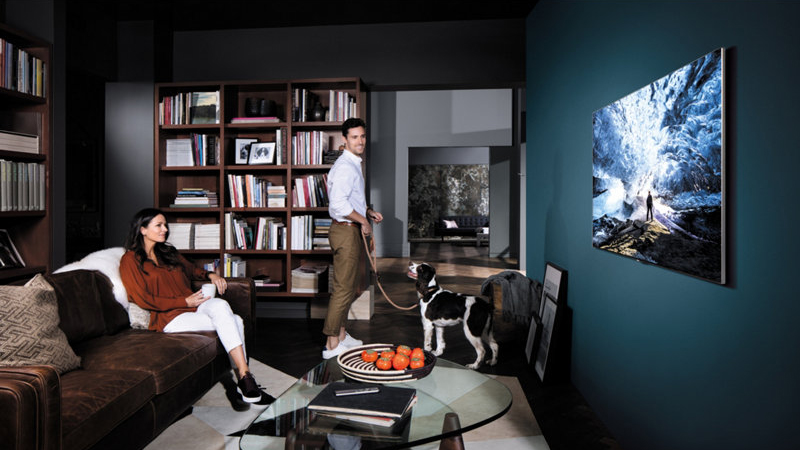TechRadar Verdict
If you’re looking for an eye-catching addition to your living room and don’t mind a few niggling issues, Samsung’s Q7F is a excellent option.
Pros
- +
Gorgeous colors
- +
Unprecedented brightness
- +
Amazing upscaling
Cons
- -
Poor black levels
- -
Apps hang periodically
- -
Inconsistent sound system
Why you can trust TechRadar
QLED is delivering on Samsung’s promise of better, brighter screens at a more affordable price, with the Samsung Q7F leading the charge as the manufacturer’s entry-level set.
If you missed the memo on Samsung QLED TVs, don’t fret. In short, they’re brighter, more colorful panels that use a technology called metallic quantum dot to enhance a screen’s performance. They’re a continuation of Samsung’s SUHD series that it started a few years ago, but have raised the brightness to an unprecedented level and incorporated a nearly transparent optical cable that links the TV to Samsung’s One Connect I/O hub.
What does all this technology do? It makes a pretty phenomenal TV that might not have the black level chops of an OLED, but has plenty of brightness that makes colors pop like never before. Samsung’s line-up of QLED screens might not be the best value in TVs this year, but there’s no doubt that they’re packing showstopping performance under the hood.
- What is QLED TV, and why should you care?
- OLED vs QLED: battle of the TV panels
Design
Samsung’s introductory QLED screen, Q7F comes in three sizes: a 55-inch, a 65-inch and a massive 75-inch version. The middle brother, the 65-inch version, costs $2,799 (£3,099, around AU$3,574) and it’s the subject of this review.
That said, all three iterations share the same design aesthetic – namely, an elongated stand, a nearly non-existent bezel and the aforementioned ‘invisible’ optical cable that connects the screen to the One Connect I/O hub.

Setting the screen up doesn’t take long, especially if you use the included swivel stand rather than wall mount the screen. Setup involves mostly threading wires through the back of the stand to create the minimalist aesthetic Samsung set out to achieve.
So what’s the deal with the giant One Connect box? It has the respectable job of housing all of the Q7F’s inputs and outputs. Instead of a half dozen wires cluttering up your TV’s beautiful, brushed-metal backside, they’ll go into the separate box instead. Connecting the box to the TV itself is a nearly transparent, proprietary optical cable. It’s a neat solution that only Samsung employs ... which might make it hard to replace if it snaps two years down the road. Still, the pros outweigh the cons here.
Screen sizes available: 55-, 65- and 75-inch | 4K: Yes | HDR: Yes | Panel technology: QLED | Smart TV: Yes, Eden 2 (Tizen) | Curved: No | 3D: No | Inputs: four HDMI, three USB, one RF In (Antenna/Cable), one Composite In, one Component In, one Ethernet, one Optical and one mini jack port
Design TL;DR: The Q7F is a beautifully trim TV that will score serious points with the minimalist in your life.
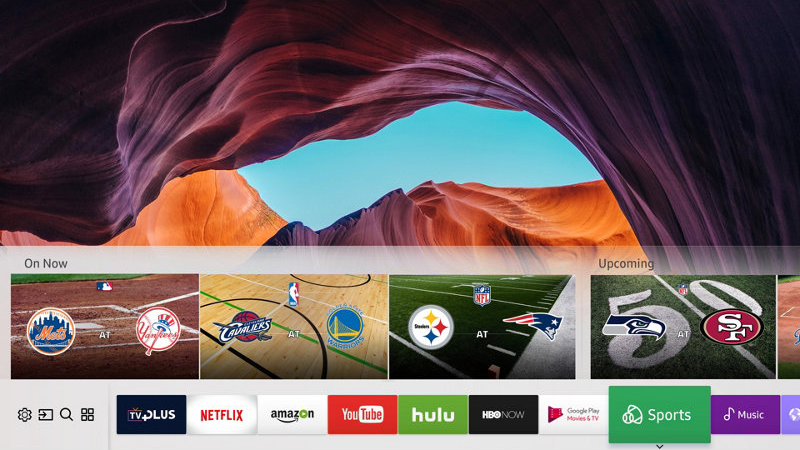
Smart TV (Eden 2, powered by Tizen)
Samsung’s smart TV system – Eden powered by Tizen – is coming along nicely. It feels just as easy to use as one of our favorite TV OSes, LG’s webOS, even if it’s a bit slower overall.
What makes this year’s iteration better is the tighter integration of voice commands into the overall package. You’ll still need to be on a text selection screen to use voice search, but it’s usually pretty accurate and saves you from typing out a long string of characters.
You’ll find most major apps on the Tizen storefront, including favorites like Amazon Video, YouTube and Netflix (all three of which have 4K support), plus the BBC iPlayer, ITV Player, All4 and My5 catch-up TV services for those living in the UK. If you’re looking for recommendations on what to watch, there’s the TV Plus app that lists new movies and shows as well as where to stream them. It’s actually a pretty nifty addition even it wasn’t something we used often.
Our biggest problem with Samsung’s OS is that it often hung on loading screens, especially on Netflix and even more often when we were first waking the TV up from sleep mode. That’s not to say the operating system is slow (transitioning from one app to another and buffering a video take a matter of seconds) but it is prone to instability.
Should you be someone who uses their phone as a second screen alongside their TV, Samsung offers a spiffy new iOS and Android app that will enable you to receive live notifications from your TV and help locate content, but the voice remote works just as well.
Smart TV TL;DR: Eden 2 powered by Tizen is a minimalistic, straight-forward OS. It’s easy to find content, but it does sometimes get hung up on a loading screen here and there.
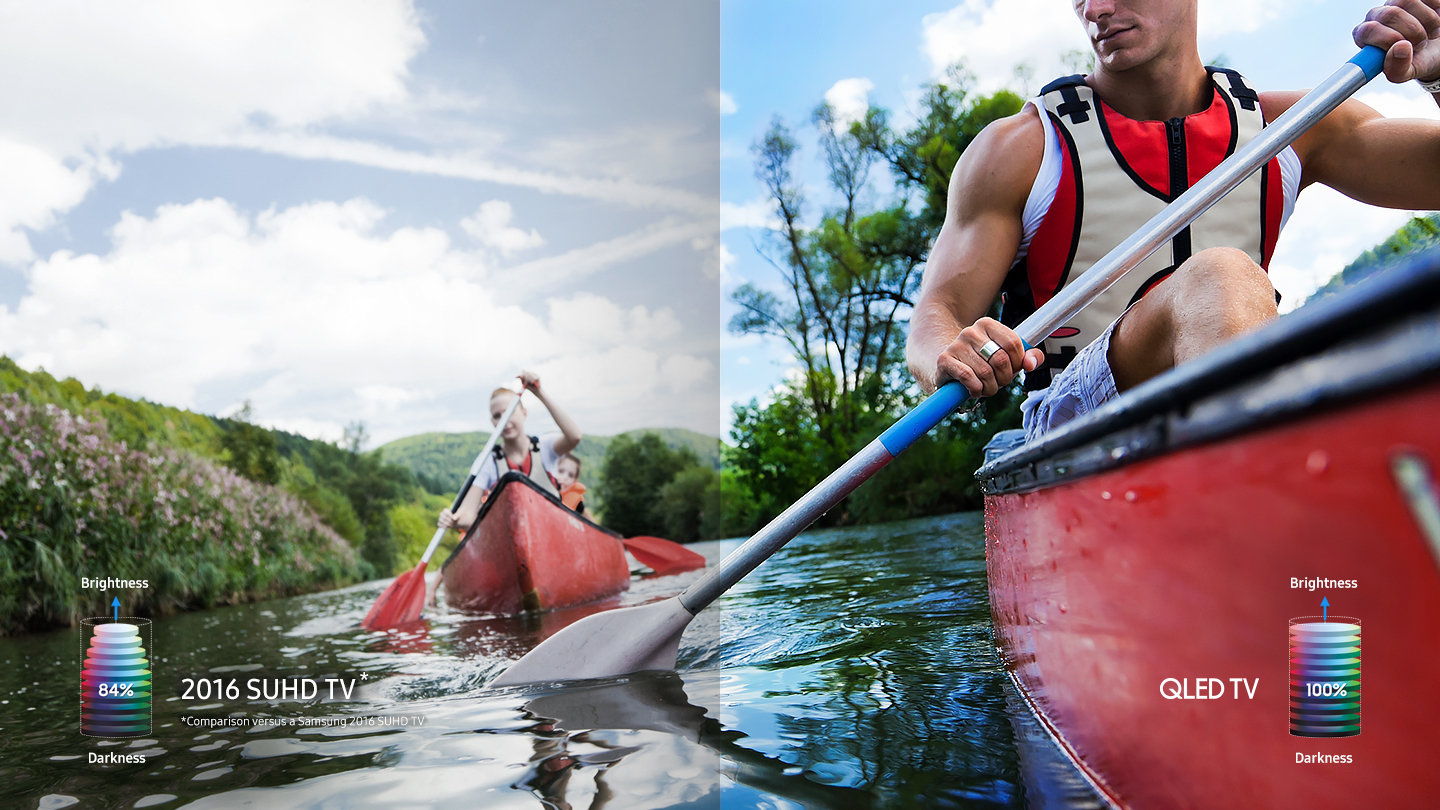
HD/SDR performance
In a perfect world, all the children of the world sing the song Kumbaya, healthcare comes free and content is delivered in native 4K HDR. Unfortunately, we’re not quite there yet. Thankfully, Samsung’s Q7 QLED TV does an exceptional job upconverting standard HD/SDR content into near immaculate 4K HDR images.
We tested a number of streaming services and types of content – from clips and livestreamed video game tournaments on YouTube, to movies and shows on Netflix and Amazon and even games using our PS4 Slim and Xbox One – and each time walked away impressed with the Q7F’s performance.
Fundamentally, the same things that help make the Q7F such an extremely bright and colorful 4K/HDR streamer come in handy for HD/SDR streams as well – the panel’s metallic quantum dots give undersaturated films from the late ’90s or early aughts a splash of color, and Samsung’s upscaling engine makes sure there’s little, if any, grain in the image.
Of course, this is all with Samsung’s HDR+ Mode turned on. HDR+ finds areas that have highlights (like a bright sky, for instance) and cranks up the brightness and color for these sections for an unparalleled experience. Some may find it a bit disturbing to go back and watch films that predated HDR suddenly filled to the tipping point with gorgeous backdrops, but we, for one, didn’t mind this amazing – if slightly unnatural – re-rendering.
HD/SDR TL;DR: The Q7F’s HDR+ Mode and general upscaling ability does wonders with HD/SDR content. Color us impressed.
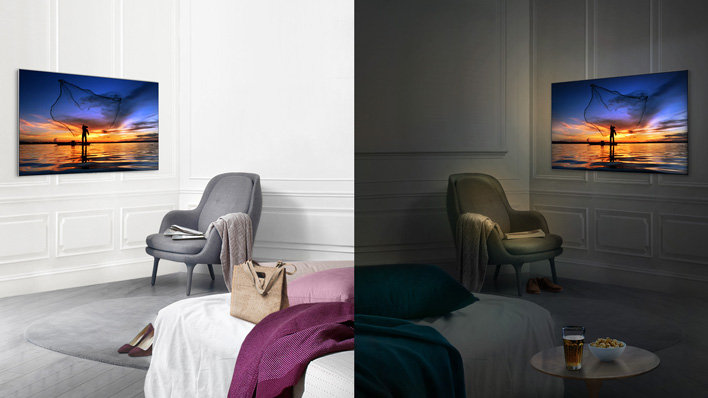
4K/HDR performance
To fly a jet, you need jet engine fuel. Similarly, when Samsung’s QLED Q7F, a premium HDR Ultra-HD TV runs some HDR Ultra-HD content, sparks fly. The Q7F does an extraordinary job enhancing colors without oversaturating them like we’ve seen on LG’s first generation of Super UHD screens that also used quantum dot filters. (CORRECTION: LG used “nano cell” and “quantum color” products that are similar to Quantum Dot but did not actually use true Quantum Dot technology in their Super UHD screens.)
While we’d like to claim it’s the brightest TV out there, it’s actually playing second fiddle to Samsung’s flagship Q9F QLED – a screen that we’ve seen achieve close to 2,000 nits of peak brightness. Even though the Q7F isn’t quite as bright as that, it’s still far and away brighter than most LCD LED TVs out there. This brightness is largely a very good thing: It makes colors pop, gives HDR scenes a ‘wow’ factor and improves contrast, three extremely important aspects of a TV viewing experience.
The trade-off, though, is that the Q7F isn’t the best TV for pitch-black black levels or for off-axis viewing. In nighttime scenes, you’ll see the TV struggle to display details in the darkness, a problem that becomes exacerbated when you’re watching the screen in a bright room during the day. At its core, remember, the Q7F is still an edge-lit LCD LED TV. That means that much of this phenomenal performance is lost when you stand or sit too far to one side of the screen or the other. It’s not a massive problem, no one we showed the TV to seemed to care, but it might be something you notice if you’ve had a lot of screen time.
All of that, though, doesn’t stop the HDR images from looking incredible.
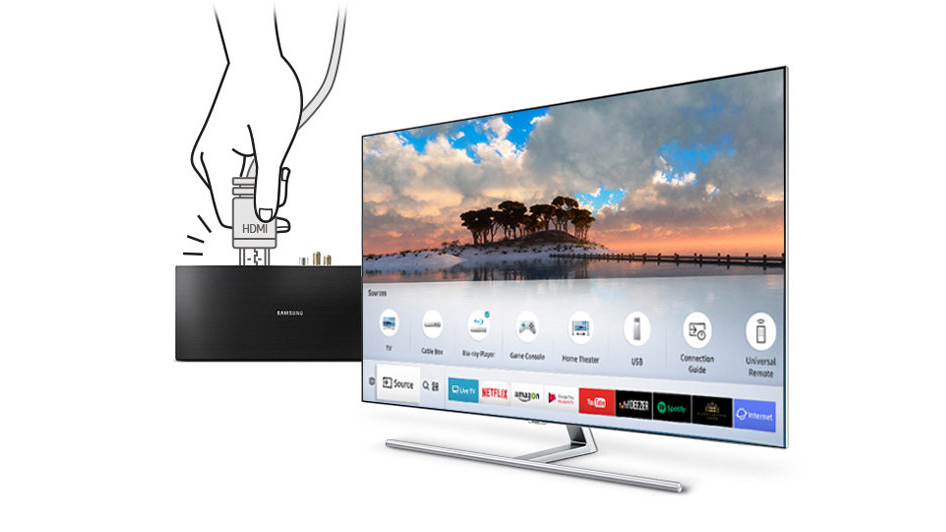
Speaking of HDR and its effects on the screen’s performance, the TV only supports HDR10. This is the basic format for HDR that most HDR Blu-ray players and game consoles support. Despite its ubiquity, HDR10 creates stunning images that will stop you in your tracks. It’d be nice if Samsung supported Dolby Vision, another even more powerful type of HDR, as well as HDR10, but it’s a minor issue and not necessarily a strike against the set.
What impressed us most, however, with the Q7F’s performance was how little tweaking we had to do to get the screen to peak performance levels. While other screens might require weeks of tampering and testing to get just right (for those of us not using spectrometers), Samsung’s Q7F comes out of the box ready to be enjoyed.
4K/HDR performance: Less-than-ideal black levels aside, this is a tremendously bright, colorful TV that will leave onlookers’ jaws on the floor without much, if any, extra work.
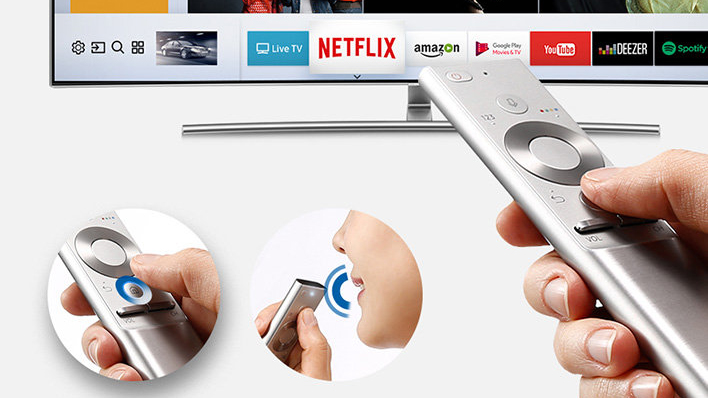
Sound
The Q7F is a looker, by every definition. It’s sleek. It’s slim. It’s designed to slip onto the media shelf. And while all of this svelteness is appreciated, it comes at the cost of a decent pair of built-in speakers.
All things considered, the Q7F rarely gets things right in the audio department. Some scenes are barely audible, even when cranked up to 80% of max volume, and others nearly blow the speakers out at only 10 or 12%. Some scenes have overbearing explosions and difficult-to-hear dialogue, while in others everything is fine. It’s paradoxical at points and can be frustrating at others.
The silver lining? Samsung makes some great, affordable soundbars, including one of our favorite pieces of audio equipment in 2017, the Samsung HW-MS650 Sound+ Soundbar. Buying more hardware isn’t an ideal solution, but there are worse problems to have.
Other panels to ponder
We’ve been treated to an excellent year in televisions in 2017 – especially in the mid-to-high tier range that Samsung’s Q7 QLED sits in. Alongside the Q7F in the QLED line-up is the Samsung Q8C QLED, a curved version of the QLED technology, and the Samsung Q9F QLED, which has an even higher peak brightness. The Q7F’s siblings are a fair bit more expensive than the Q7F, however, and unless you’re going to invest a small fortune for the high-end Q9F, you can stick to the Q7F for the best price-to-performance ratio.
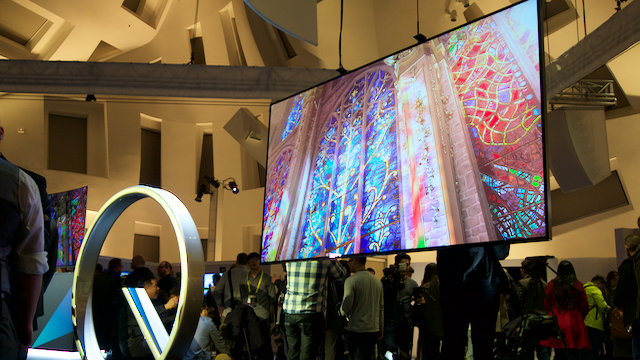
Outside of Samsung, you should probably look at both LG and Sony. In LG’s stable this year are the 2017 OLED TVs including the affordable-ish LG B7 OLED and LG C7 OLED. If you’re comparing apples-to-apples they’re a bit costlier, but if you’re willing to compromise on size and pick up a 55-inch instead of a 65-inch screen, they’ll come out to roughly the same price. What you get in that trade is much better contrast and black levels but trade away some of the screen’s adeptness with the brighter end of the HDR spectrum.
So what is Sony offering? One of our favorite screens this year in that coveted mid-to-high tier range is the Sony BRAVIA XBR-65X850E (KD-65XE8596 for you UK folks). It’s a little bit more cost-effective at only $1,599/£2,200 but runs on Android TV, which can be a bit finicky.
Final verdict
The Samsung Q7F QLED is an extraordinary TV hindered by ordinary issues. It’s one of the brightest, most colorful and we daresay one of the most enjoyable TVs to watch from Samsung in 2017. And while it would be nice to unequivocally recommend it, some damning black level performance, issues with off-axis viewing, audio and operating system performance keep on the most beautiful TVs from being one of this year’s best.
Overall, however, if you’re looking for an eye-catching addition to your living room and don’t mind investing in a soundbar to compensate for the built-in speakers, Samsung’s Q7F is a excellent option.
Nick Pino is Managing Editor, TV and AV for TechRadar's sister site, Tom's Guide. Previously, he was the Senior Editor of Home Entertainment at TechRadar, covering TVs, headphones, speakers, video games, VR and streaming devices. He's also written for GamesRadar+, Official Xbox Magazine, PC Gamer and other outlets over the last decade, and he has a degree in computer science he's not using if anyone wants it.
